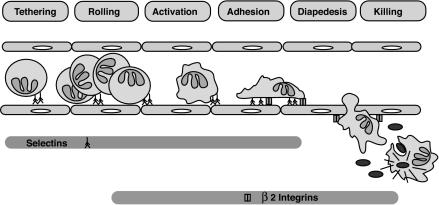FIG. 4.
Neutrophil responses to infection. Initial interactions are mediated by P-selectin, which is released from Weibel-Palade bodies in endothelial cells on exposure to C5a, leukotriene B4, TNF-α, or LPS. E-selectin is expressed subsequently, and together they bind fucosylated glycoproteins on the tips of neutrophil surface villi. This initial interaction is often termed rolling. IL-8 and other chemokines cause a conformational change in neutrophil surface integrins and allow binding to ICAM-1 and ICAM-2, which are induced on inflamed endothelial cells. Extravasation requires the β2-integrins and PECAM (CD31). Migration toward C5a, bacterial peptides, or a chemokine gradient is mediated by interactions with cell surface receptors and cytoskeletal changes. Resident tissue macrophages produce chemokines in response to pathogen recognition receptor engagement. Phagocytosis is activated by the binding of complement receptors, immunoglobulin receptors, or TLRs. Once engulfed, bacteria are killed by the combined actions of granule contents and reactive oxygen species. Rolling is defective in LAD 2, tight adhesion is defective in LAD 1, and chemotaxis is defective in Chédiak-Higashi syndrome, specific granule deficiency, Schwachman syndrome, myelokathexis, and glycogen storage disease type Ib. Phagocytosis is defective in LAD 1, and intracellular killing is defective in CGD, specific granule deficiency, Chédiak-Higashi syndrome, myeloperoxidase deficiency, myelokathexis, and glycogen storage disease type Ib.

